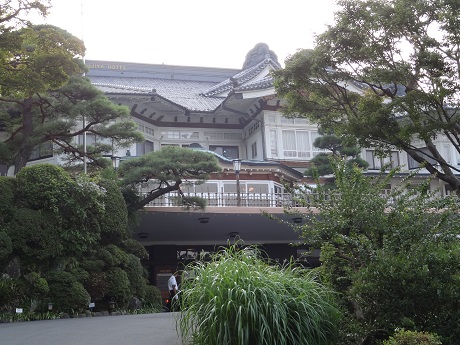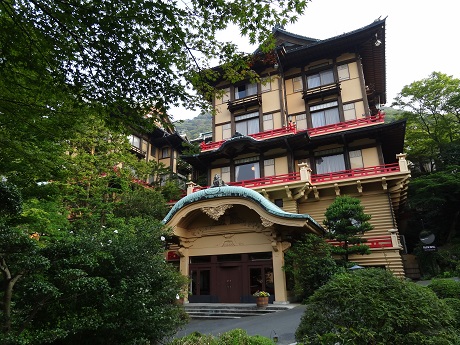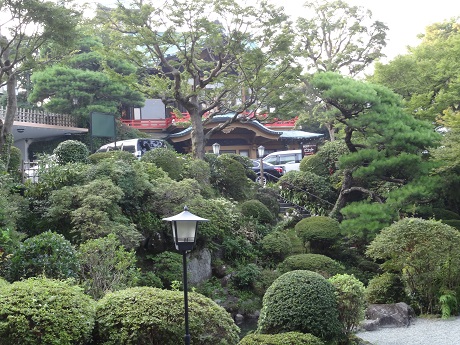Posts Tagged ‘Japan’
-
The Fujiya Hotel Part 1
0August 9, 2013 by IPAlchemist
How shall I write the praises of the Fujiya Hotel? I was completely captivated by it the first time I came across it, a few years ago when my friend Keizo was showing me around Hakone.
You need I think to consider a little the history. The founder Sennosuke Yamaguchi travelled to the USA and Europe and learned something of the Western hotelier tradition in the early Meiji period, and founded his hotel in 1878. It was apparently the first western-style hotel in Japan (if this is not strictly true it must have been one of the first), in the resort area of Hakone, popular even then. The original building burned down in the Miyanoshita fire in 1883, so the current main building dates from 1891. War, earthquake and fire means that even in a country so historic as Japan, Meiji period buildings are something of a rarity, so it is for me an enormous joy to be staying in an original Meiji building.
When we say “Western-style” we mean “Japanese interpretation of Western style” – it does not look anything like anything one might find in the actual West. The original building and most of the later additions are actually very Japanese in character, although with clear western influences. The result for me seems like a Japanese re-interpretation of a Swiss chalet.
Buildings were added in the late Meiji and Taisho periods (early 20th century), the former just after Japan’s success in the Russo-Japanese war, but I am most drawn by the two phases of later additions – one in the early Showa period, when Japan was expanding its empire in east Asia, and the second in the 1960s, when Japan was rebuilding itself. Through all these turbulent times, the Fujiya was trying to bring rest and relaxation to those in need. There is a museum in the basement chronicling some of the history, including a visit from the Showa Emperor himself in the 1960s. What it must have been like to be visited by a being sometime considered to be divine.
Although setting out to be a Western style hotel, the Fujiya is in fact based around that most Japanese of leisure attractions – the onsen or hot spring. That is what Hakone is famous for, and that is what you get at the Fujiya. There is a small public bath (separated by gender), a large onsen swimming pool that is mixed, and for which bathing costumes are required, but then the crowning glory is onsen water piped into the bath in your own room’s bathroom, through what appears to be genuine Meiji era plumbing. Guests are advised that the hot water can take up to 10 minutes to arrive. I think it actually takes longer.
The buildings are caked in layers of paint; modern additions such as electricity, air conditioning and internet are delivered in conduits attached to the original structure; and yet… And yet… The historic charm of years of people staying and relaxing here oozes enticingly out of every beam, windowframe, and wooden floortile.
The service, while certainly better than anything in hotels in London, does not quite achieve the effortlessly inconspicuous ideal of the Okura, but you have to pity staff who must deal, displaying Japanese politeness, with not only huge parties of staying guests, but also streams of tourists who come, alone or in groups, like Keizo and I did those years ago, just to ogle and perhaps have tea.
The building itself is very hard to photograph, set as it is upon a hill, and obscured from most directions by trees, but I will have a go.
The Main Building 1891
The Flower Palace 1936
The Restaurant – added 1930
The feeling of having got away from it all is greatly increased by choosing the correct way to arrive. Short it is not – it took a full four hours from Narita airport. The route is this: limousine bus to Shinjuku Station bus station; Odakyu railway Romance Car to Hakone Yumoto, and then Tozan railway three stops to Miyanoshita. It is this last bit that makes it all worthwhile – the train ascends nearly 500m in altitude in a series of 3 switchbacks, at each one of which the two drivers swap ends, climbing though thick vegetation, featuring densely packed hydrangeas. It was glorious. Then you just have to heft your luggage downhill then uphill for about 500m and then you are there.
A rather less welcome reminder of having got away from it all is the discovery that the nearby ATM does not accept foreign issued credit cards, followed by being politely informed by the hotel staff that they do not advance cash on cards, that there is no suitable ATM nearby, and that the nearest one that can be used is at Miyanoshita Post Office, not walkable, requiring a train, bus or taxi journey. Oh and the machine only functions until 6pm.
The odd thing is that despite the remote feeling, it is actually not remote at all by any objective standard. It is on the route of the old Tokaido road – the main route from Tokyo to Kyoto, and the current Japanese Route 1. So it is actually about as well connected as it is possible to be and still be apparently in the middle of nowhere. The road, despite its impressive moniker, is at this stretch only single carriageway and very twisty.
The main business of the day, however, was to have another tea like the one that had first enchanted me so much. So that is the subject of my next post.
Category Leisure, Travel | Tags: Fujiya Hotel, Hakone, Japan, Miyanoshita, tozan railway
-
Visiting Tokyo and Kyoto – Darren’s Recommendations
0November 17, 2012 by IPAlchemist
Dr Jess, known on Twitter as @JessTheChemist, is off to Japan to go to a conference in Kyoto, and has asked for recommendations while there. It is not the first time that I have been asked for such suggestions, as I lived in Tokyo for two years 1996-1998, and have been back most years since 2001, so it seemed worth putting my thoughts on a blog post so that they are there for anyone else too. So here goes.
KYOTO
There is too much to see in Kyoto. I have only seen a tiny fraction – for example, I have never visited the old Imperial Palace.
Things I have seen and would recommend (which I remember as “the one with…”) are as follows:
Kiyomizu-dera
This is one of the most famous temples and is considered a “must see”. Avoid the young people offering to guide you around in return for practising their English – they are annoying and know nothing about the place.
Kinkaku-ji (The Golden Temple)
The one with the gold-covered temple pavilion, and is also generally considered a “must see”.
Ginkaku-ji (The Silver Temple)
The one with the frustoconical pile of sand. (Confusingly, there is no silver temple pavilion in it). Also features high on the tourist agenda.
Sanjusangen-do
The one with 1001 buddha statues which was one of my favourite Kyoto sights.
Nijo-jo
Called a castle, but actually it was a palace for the Shogun. Civil architecture a welcome relief from all the temples.
Ryoan-ji
The one with the garden with 15 stones and a wall with a funny stain. (If you don’t go here, try to go to another Zen stone garden – you should probably try to take in one).
Nishi Hongan-ji
Worth visiting if you are in the area (which is likely since it is close to Kyoto station). It has a huge impressive main hall.
Myoshin-ji
The one with the dragon on the roof and the mediaeval sauna. This is a great place – a temple in a huge temple complex. I think it is not on the general tourist circuit, and, at least when I went, was very much less busy than anywhere else I ever went to. Description here.
I wouldn’t bother with the Heian Shrine, which is modern and dull. This is my only anti-recommendation.
I treasure two shopping experiences as well.
Jusanya, which sells boxwood combs and is situated in a lovely market (location described here.)
Aritsugu, which sells Japanese kitchen knives, a work of art in themselves. Also in a nice market (location described here.)
NARA
If you never saw anything at all in Kyoto, but instead got on the train and spent the whole time in Nara, I don’t think you would have made a bad decision.
The usual tour includes Nara park (with the deer, to which you can feed rice crackers that they sell there) and Todai-ji – the one with the giant Buddha statue. Both of which are lovely.
For me, the real treasure is Horyu-ji, which is my favourite temple in Japan. It claims to be the oldest wooden structure in the world. The atmosphere there is quite magical. If I could see only one thing in Japan again, this would be it.
But also very highly recommended is the Toshodai-ji, in a different part of Nara, and also quite lovely. It recently emerged from a long period of refurbishment, I am told.
TOKYO
There is nothing old in Tokyo, basically, so if you want to see traditional Japanese stuff, then you probably need to do a day trip. My recommendation would be Nikko, but Kamakura is also popular. If you stay within Tokyo itself, then Asakusa has a temple which compares reasonably favourably with those in other parts of Japan. (Any Tokyo apologists reading this – sorry, but you know it’s true!)
If I could do only one thing in Tokyo, it would be to have lunch or dinner in the restaurant Ukai Toriyama (website here.) It is a way out of central Tokyo, and you have to take the Chuo line out to Takao-san, and then a minibus supplied by the restaurant, but it is doable if you seek guidance, for example from your hotel (or just the restaurant website). The journey take about an hour.
I will now get down to serious heresy. People talk about the different parts of Tokyo having different characters, but I find that many of the main department stores, for example, repeat all over central Tokyo, and so rather than fight your way to Ginza or Nihonbashi, you might as well look out the Mitsukoshi or Takashimaya that is closest.
On the subject of department stores, most have restaurant floors, usually near the top, and these are rarely a bad place to look out to eat. You get a very large selection of eating possibilities in a small space, and usually with pictures or models that will give a good idea of what the food is likely to be.
If you get a clear day, find a tall building with public access and admire the view. These used to be in short supply (and I used to recommend tea or cocktails in the lobby bar at the Park Hyatt in Shinjuku – I swear I did this before it appeared in Lost in Translation) but so many tall buildings have sprung up since my time that it is hard to avoid finding one. So there seems very little point in going to Tokyo Tower any more.
If you fancy seeing Mount Fuji from Tokyo, which can be done especially in winter, the best time is first thing in the morning. Daytime or evening it usually gets hazy. You don’t need a particularly tall building (I used to see it from 5th floor at Tokyo Institute of Technology), but you do need uninterrupted view in the right direction, and this can now be hard to find.
I expect more thoughts will come to me over time, in which case I will add them.
Category Travel | Tags: Japan, Kyoto, Nara, Tokyo



